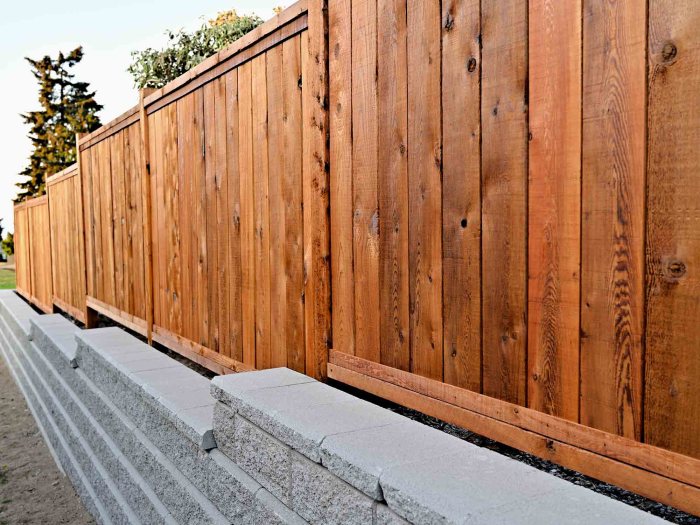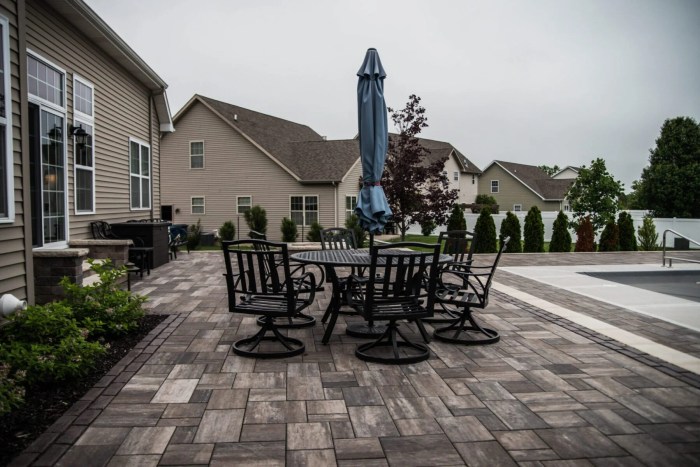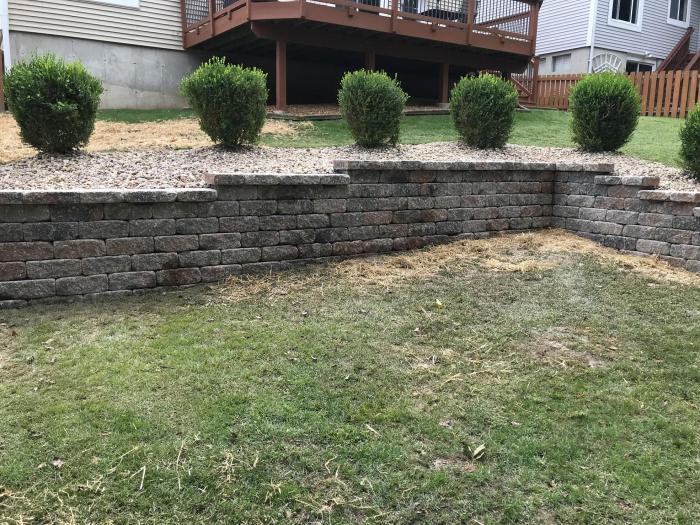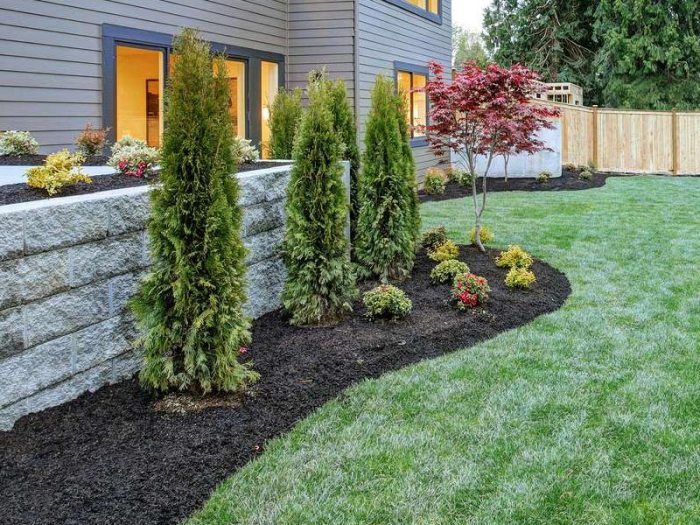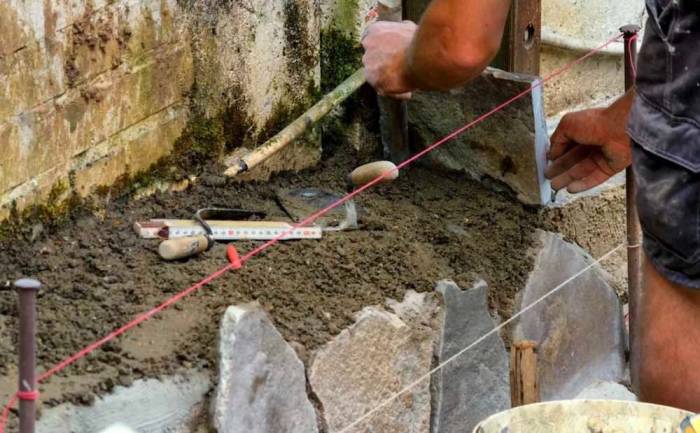Milwaukee Retaining Walls A Comprehensive Guide
Milwaukee retaining walls are a crucial element in shaping the city’s landscape, offering both aesthetic appeal and crucial support for diverse environments. This guide delves into the intricacies of these structures, from their historical evolution to modern design considerations, construction methods, and maintenance strategies. We’ll explore the materials used, the design principles, and the environmental impact of these essential elements.
Understanding the specific characteristics of Milwaukee’s soil conditions, topography, and local regulations is paramount in designing effective retaining walls. Factors like drainage and structural capacity need careful consideration to ensure longevity and stability. The guide further investigates various construction methods, highlighting their strengths and weaknesses, and emphasizes the importance of proper excavation and reinforcement techniques. Furthermore, we’ll examine the vital aspects of maintenance, repair, and potential environmental impacts, ultimately providing a complete perspective on these important structures.
Introduction to Milwaukee Retaining Walls
Milwaukee retaining walls are crucial infrastructure elements in the city, designed to stabilize sloped terrains and prevent soil erosion. Their unique characteristics often involve adapting to the city’s varied topography and incorporating local building materials. These walls have evolved significantly over time, reflecting advancements in construction techniques and materials availability.
The evolution of Milwaukee retaining walls has been intertwined with the city’s growth and development. Early examples likely utilized readily available materials like stone and timber, while modern designs incorporate more sophisticated engineering principles and a wider array of construction materials, leading to increased durability and aesthetic appeal.
Common Materials Used
Milwaukee retaining walls frequently employ a combination of materials, chosen based on factors like cost, availability, and desired aesthetic. Concrete, a popular choice, offers significant strength and durability. Stone, particularly local stone varieties, is sometimes preferred for its aesthetic appeal and inherent strength. Other materials, like steel reinforcement, may be used for enhanced stability, especially in taller or more complex designs. Wood is occasionally used, but less frequently due to its susceptibility to decay compared to other materials.
Types of Milwaukee Retaining Walls
Different types of retaining walls cater to various site conditions and design requirements. These structures are often classified by their structural mechanism.
| Type | Material | Typical Height | Application |
|---|---|---|---|
| Gravity | Concrete, Stone | Up to 6 feet | Suitable for relatively flat or gentle slopes, where the weight of the wall itself provides sufficient stability. Common in residential settings. |
| Anchored | Concrete, Steel | 6-15 feet | Employing steel anchors to provide additional support, often for moderate to steep slopes. More robust than gravity walls and can handle larger retaining loads. |
| Cantilever | Concrete, Steel | 15 feet and above | Utilizing the structural properties of a beam or slab, usually concrete, extending out to resist the soil pressure. Suitable for high retaining walls on steep slopes or complex terrain. |
Design Considerations for Milwaukee Retaining Walls
Milwaukee retaining walls require careful consideration of various factors to ensure stability, longevity, and functionality. Proper design minimizes the risk of failure and costly repairs. A thorough understanding of local soil conditions, topography, and regulations is crucial. This section will delve into essential design considerations for retaining walls in Milwaukee.
Site assessment is paramount in designing retaining walls. A thorough investigation of the site’s characteristics helps anticipate potential issues and tailor the design accordingly. This involves evaluating soil properties, identifying potential drainage challenges, and considering the existing topography.
Importance of Site Assessment
A comprehensive site assessment provides crucial data for the design process. This involves evaluating soil types, bearing capacity, and moisture content. Understanding the soil’s properties helps determine the appropriate foundation design and wall geometry. The assessment also identifies potential drainage issues, such as surface water runoff and groundwater levels, which are critical for wall stability. Furthermore, the site’s topography influences the wall’s design. Steep slopes or uneven terrain require specific design considerations to ensure stability.
Factors Influencing Milwaukee Retaining Wall Design
Several factors influence the design of retaining walls in Milwaukee. Soil conditions play a critical role, affecting the wall’s required structural capacity. Topography, including slope angles and existing features, significantly impacts the wall’s design. Local building codes and regulations set standards for wall construction and materials, ensuring compliance with safety guidelines.
Calculating Structural Capacity
The retaining wall’s required structural capacity is calculated based on soil pressure. Soil pressure is the force exerted by the soil against the wall. The calculation considers the soil’s properties, the height of the wall, and the angle of repose. A crucial element is the active earth pressure, which represents the minimum pressure against the wall. A common formula for calculating active earth pressure is:
Pa = 0.5 * γ * H^2 * Ka
Where:
- Pa = Active earth pressure
- γ = Unit weight of soil
- H = Height of the retaining wall
- Ka = Coefficient of active earth pressure
The coefficient of active earth pressure (Ka) depends on the soil’s friction angle and the wall’s inclination. Accurate determination of these factors is essential for accurate calculations.
Key Design Considerations
| Factor | Description | Impact |
|---|---|---|
| Soil Type | The type of soil (clay, sand, silt) significantly affects the wall’s design. | Different soil types have different bearing capacities and drainage characteristics. |
| Wall Height | Higher walls exert more pressure on the soil. | Increased wall height necessitates a stronger foundation and more robust structural elements. |
| Slope Angle | Steeper slopes increase the lateral pressure on the wall. | Steep slopes require special design considerations to prevent sliding or tilting. |
| Local Regulations | Milwaukee building codes and regulations dictate standards for wall construction and materials. | Adherence to local regulations is essential for compliance and safety. |
Drainage Solutions for Milwaukee Retaining Walls
Proper drainage is crucial for preventing water buildup behind the retaining wall, which can lead to instability and erosion. Several approaches address drainage issues. One approach involves installing weep holes along the wall’s back face. These holes allow water to drain away from the wall. Another method includes incorporating a drainage layer behind the wall, such as a gravel or geotextile drain. This layer facilitates water drainage and reduces water pressure against the wall. A further approach involves diverting surface water away from the wall using gutters, swales, or other drainage systems.
Construction Methods for Milwaukee Retaining Walls
Constructing retaining walls in Milwaukee, like other regions, demands careful consideration of various factors, including soil conditions, site constraints, and budget. Selecting the appropriate construction method is crucial for a durable and cost-effective solution. This section delves into the different construction methods, their advantages and disadvantages, and the significance of proper excavation and reinforcement.
Steps Involved in Construction
The construction process for Milwaukee retaining walls typically involves several key steps. Initial site preparation, including clearing and excavation, is fundamental. This is followed by the installation of the foundation, which may include concrete footings or other appropriate support systems. The next phase involves the construction of the wall itself, utilizing the chosen materials and techniques. Finally, backfilling behind the wall with appropriate soil is essential for stability and aesthetics.
Comparison of Construction Methods
Several construction methods are available for Milwaukee retaining walls, each with unique characteristics. These include poured concrete walls, precast concrete walls, and reinforced soil walls. Poured concrete walls offer a high degree of customization and strength, but can be more expensive and time-consuming. Precast concrete walls, on the other hand, are faster to install and can be more cost-effective, but may have limited design flexibility. Reinforced soil walls leverage soil reinforcement techniques, providing a potentially more economical solution for specific site conditions.
Importance of Excavation Techniques
Proper excavation techniques are paramount for the stability and longevity of Milwaukee retaining walls. Inadequate excavation can lead to differential settlement, compromising the wall’s integrity. Careful consideration must be given to the soil type and its bearing capacity. Understanding the local soil conditions and employing appropriate excavation methods to prevent soil erosion and slope instability is crucial.
Role of Reinforcement in Construction
Reinforcement plays a vital role in enhancing the structural integrity of Milwaukee retaining walls. Reinforcement can be achieved through steel reinforcement bars, geogrids, or other appropriate materials. This reinforcement helps to counteract the lateral pressures exerted on the wall by the soil, improving its resistance to failure. The specific type and amount of reinforcement depend on the soil conditions, wall height, and other site-specific factors.
Table of Construction Methods
| Method | Materials | Time (Estimated) |
|---|---|---|
| Poured Concrete | Concrete, steel reinforcement, and forms | Moderate to High |
| Precast Concrete | Precast concrete panels, anchors, and concrete | Moderate |
| Reinforced Soil | Soil, geogrids, geotextiles, reinforcement | Low to Moderate |
Note: Time estimates are approximate and can vary based on project complexity and site conditions.
Maintenance and Repair of Milwaukee Retaining Walls
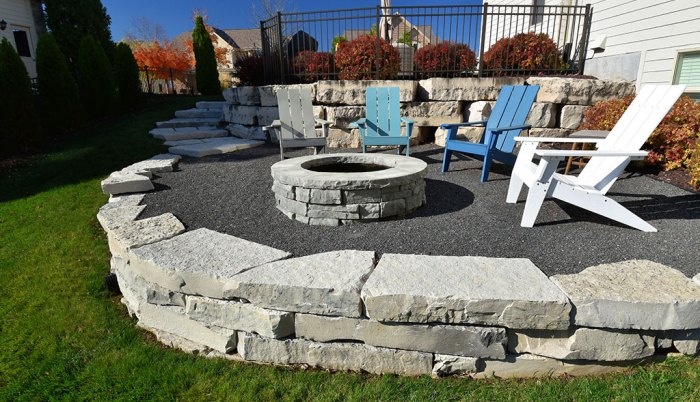
Source: integritylandscapeservices.com
Proper maintenance and timely repair are crucial for the longevity and structural integrity of Milwaukee retaining walls. Neglecting these aspects can lead to significant issues, impacting both the aesthetic appeal and functional capacity of these vital structures. A proactive approach to maintenance can prevent costly repairs and ensure the safety of surrounding areas.
Importance of Regular Inspections
Regular inspections are paramount to identifying potential problems early. This proactive approach allows for timely interventions, preventing minor issues from escalating into major structural failures. Early detection and resolution of issues such as cracks or settlement significantly reduce the likelihood of costly repairs or even catastrophic wall collapse. The frequency of inspections should be tailored to the specific conditions of the retaining wall, taking into account factors like soil type, wall height, and environmental influences.
Common Issues and Preventive Measures
Several issues can arise with Milwaukee retaining walls, requiring attention and repair. These issues often stem from environmental factors or poor initial design and construction.
- Cracks: Cracks in the wall can indicate stress or movement. Properly installed drainage systems and regular monitoring can mitigate these issues. Regular inspections allow for early identification and treatment of these problems. The type and extent of the crack determine the appropriate course of action, which might range from minor repairs to complete reconstruction.
- Settlement: Settlement, characterized by a gradual sinking or shifting of the wall, is often caused by uneven soil conditions or insufficient foundation support. A thorough site analysis, during the design phase, can help mitigate settlement risks. Employing appropriate soil stabilization techniques and regular monitoring can help prevent or minimize the impact of settlement.
- Erosion: Erosion, particularly at the base of the wall, is a significant concern, especially in areas with high rainfall or fluctuating water tables. Installing proper drainage systems and using erosion-resistant materials can help minimize erosion. Erosion control measures, such as retaining vegetation or installing drainage systems, can help mitigate this issue.
Repair Techniques
Several techniques are used for repairing retaining wall issues. The selection of the most appropriate method depends on the nature and extent of the damage.
- Crack Repair: Cracks can be repaired using various methods, including epoxy injections, grouting, or concrete patching. The severity of the crack dictates the chosen repair method. Thorough cleaning and preparation of the crack are essential before any repair work.
- Settlement Repair: Addressing settlement often involves reinforcing the foundation or stabilizing the soil. This might involve underpinning, adding soil stabilization, or implementing other geotechnical solutions. The specifics of the repair depend on the underlying causes of the settlement.
- Erosion Repair: Erosion can be addressed by improving drainage, installing retaining structures, or planting vegetation. These techniques work to stabilize the soil and prevent further erosion. The appropriate method for erosion control depends on the severity of the erosion and the specific site conditions.
Inspection Method
A systematic inspection process is essential for identifying potential issues early.
- Visual Inspection: A thorough visual examination of the entire wall, including the base, top, and sides, is crucial. Look for cracks, bulging, settlement, or signs of erosion.
- Drainage Assessment: Inspect the drainage systems around the wall to ensure proper water flow. Blocked or inadequate drainage can contribute to erosion and instability.
- Soil Condition Evaluation: Assess the soil conditions around the base of the wall. Compaction or instability in the soil can affect the wall’s stability.
- Documentation: Document all findings, including photographs, sketches, and written descriptions of any observed issues. This detailed record is essential for tracking progress and evaluating repair needs over time.
Applications and Examples of Milwaukee Retaining Walls
Milwaukee retaining walls, with their robust construction and diverse design options, find applications in a wide range of settings. Their ability to stabilize sloped terrains and create aesthetically pleasing landscapes makes them a valuable asset for residential, commercial, and public projects. Proper selection and design are key to maximizing the benefits of these walls.
Milwaukee retaining walls effectively address slope instability and create usable space in challenging terrain. Their versatility allows for integration into a variety of landscape designs, enhancing both function and aesthetics. Careful consideration of site-specific conditions is crucial for successful implementation.
Residential Applications, Milwaukee retaining walls
Residential retaining walls frequently serve to define property boundaries, improve grading, and create terraced gardens. These walls can be customized to match the home’s architectural style and enhance the overall curb appeal. The design and materials can range from simple stone walls for privacy to more elaborate structures with built-in seating areas. Consideration should be given to the expected lifespan of the wall, the local soil conditions, and the desired aesthetic impact.
Commercial Applications
Commercial projects often benefit from retaining walls to create parking areas, level out uneven terrain for loading docks, or to define areas within large properties. In these contexts, durability and longevity are paramount. For instance, a commercial development might utilize a concrete retaining wall to support a multi-level parking structure or a retail area with varying levels. Careful engineering is essential to ensure the wall can withstand the anticipated loads and traffic.
Public Applications
Public spaces, such as parks and playgrounds, often utilize retaining walls to create accessible and safe areas, incorporating landscaping and recreational elements. Examples include retaining walls to create tiered seating areas for public gatherings, support pedestrian walkways along sloped areas, or enhance the visual appeal of parks. Design considerations for public spaces will include accessibility requirements and the need for durability to withstand various weather conditions.
Enhancement of Landscape Design
Retaining walls can dramatically enhance landscape design by creating visual interest, defining different levels, and improving overall aesthetics. A well-designed retaining wall can act as a focal point or seamlessly blend into the surrounding environment. Landscaping features, such as plants and shrubs, can be strategically incorporated to create depth and texture. The wall’s material, color, and texture are crucial elements in achieving the desired aesthetic.
Improved Site Stability
Retaining walls significantly improve site stability by preventing soil erosion and landslides. This is particularly important in areas with steep slopes or unstable soil conditions. Proper design and construction, adhering to local building codes, are essential to ensure the wall’s effectiveness in supporting the weight of the soil and any structures above it. The stability of the soil and the specific site conditions will dictate the type of retaining wall appropriate.
Factors in Selecting the Right Type
The optimal type of retaining wall depends on various factors, including the height of the wall, the type of soil, the budget, and the desired aesthetic. Factors such as soil type, drainage, and local regulations should be considered before making a decision. The cost of materials, construction, and maintenance should be considered. Different wall types, such as concrete, stone, or composite, have different strengths and weaknesses, influencing the suitability for specific applications.
Application Examples Table
| Application | Challenges | Solutions |
|---|---|---|
| Residential – terraced garden | Maintaining a level surface, controlling water drainage | Proper drainage systems, carefully selected retaining wall materials |
| Commercial – parking structure | Withstanding heavy loads, potential for water damage | Reinforced concrete walls, effective waterproofing measures |
| Public park seating area | Accessibility, durability in public use | Design complying with ADA guidelines, use of weather-resistant materials |
Environmental Impact of Milwaukee Retaining Walls
Constructing retaining walls, while crucial for stabilizing slopes and improving land use in Milwaukee, can have environmental consequences. Understanding these impacts is essential for responsible development and mitigating potential harm to local ecosystems and wildlife. Careful consideration of construction methods, material choices, and post-construction management can significantly reduce these negative impacts.
Construction Impacts on Local Ecosystems
Construction activities, such as excavation and site preparation, can disrupt existing vegetation and soil structures. This disturbance can negatively affect local biodiversity by impacting habitats for various species, including insects, birds, and small mammals. Disturbed soil is also more susceptible to erosion, potentially leading to sedimentation in nearby water bodies, harming aquatic life. The introduction of construction materials and equipment can also introduce contaminants into the soil and water, impacting the health of the ecosystem.
Mitigation Strategies for Environmental Impact
Minimizing the environmental footprint of retaining wall construction requires a proactive approach. Before construction, conducting thorough site assessments is crucial. This assessment should include identifying sensitive areas, such as wetlands and wildlife corridors, to avoid disrupting critical habitats. Employing techniques like minimizing the footprint of excavation and using temporary erosion control measures can help prevent sedimentation and soil disturbance. Careful selection of construction materials can also play a vital role in minimizing the environmental impact.
Sustainable Material Options
Sustainable material choices for retaining walls are crucial for minimizing the environmental impact of construction. Recycled materials, such as concrete made from recycled aggregate, offer a viable alternative to virgin materials. These recycled materials reduce the demand for raw materials and lower the carbon footprint of the construction process. Consideration should also be given to locally sourced materials, reducing transportation emissions. Using timber or stone, if appropriate to the site conditions, can also contribute to a more sustainable approach.
Sustainable Practices in Milwaukee Retaining Wall Construction
A comprehensive approach to sustainable retaining wall construction involves multiple factors.
- Prioritizing site assessment and mitigation: Identifying and preserving sensitive areas during the planning phase minimizes ecological disruption. This includes detailed surveys of existing vegetation, wildlife corridors, and water bodies.
- Minimizing soil disturbance: Employing precise excavation techniques and using appropriate erosion control measures reduces soil erosion and sedimentation, protecting water quality and local ecosystems.
- Employing sustainable materials: Utilizing recycled materials and locally sourced options reduces the environmental impact of transportation and raw material extraction.
- Implementing post-construction restoration: Replanting native vegetation and restoring disturbed areas helps re-establish ecological balance and biodiversity.
- Implementing water management strategies: Controlling runoff and managing water infiltration during and after construction minimizes the impact on local waterways and prevents soil erosion.
Regulations and Permits for Milwaukee Retaining Walls
Constructing retaining walls in Milwaukee, like any significant construction project, requires adherence to specific regulations and permits. These regulations are in place to ensure public safety, protect property values, and maintain the city’s infrastructure. Understanding these requirements is crucial for both homeowners and contractors.
Obtaining the necessary permits and complying with local regulations is vital for a smooth and legally sound construction process. Failure to do so can result in delays, fines, and even project termination. This section details the specific regulations and permits needed for retaining wall construction in Milwaukee.
Permits Required for Milwaukee Retaining Walls
The specific permits required for retaining walls in Milwaukee depend on the project’s scale and complexity. A comprehensive permit application will typically encompass several types of permits, ensuring all aspects of the project meet city codes. Commonly required permits may include building permits, site plan approval, and potentially erosion control permits, among others.
Local Authorities for Obtaining Permits and Guidelines
The primary local authority responsible for overseeing retaining wall construction in Milwaukee is the City of Milwaukee Department of Public Works or a similar designated department. Their website and associated documentation provide detailed information on permit requirements, application procedures, and relevant guidelines. Furthermore, consulting with a qualified engineer specializing in retaining wall design is advisable. They can provide critical insights and guidance throughout the permitting process.
Permit Application Process for Milwaukee Retaining Walls
The application process typically involves submitting detailed plans and specifications to the relevant authority. These documents should delineate the wall’s dimensions, materials, drainage system, and foundation details. The applicant should also be prepared to demonstrate compliance with local zoning ordinances and building codes.
- Submit a comprehensive application package that includes detailed plans and specifications.
- Provide supporting documents, such as site surveys and geotechnical reports, demonstrating compliance with city codes.
- Attend required meetings with city officials to discuss project details and address any concerns.
- Pay applicable fees associated with the permit application and subsequent inspections.
- Comply with all inspection requirements and resolve any outstanding issues promptly.
Potential Liabilities and Responsibilities
Property owners and contractors undertaking retaining wall construction bear significant responsibility for the project’s safety and compliance. Failure to adhere to regulations can lead to legal liabilities, including potential lawsuits for damages caused by poorly constructed or maintained walls. Proper design and construction are paramount to avoiding such liabilities.
Summary of Milwaukee Retaining Wall Permitting Process
| Step | Description |
|---|---|
| 1 | Application Submission: Submit a complete application package to the relevant authority, including detailed plans and specifications. |
| 2 | Review and Approval: The authority reviews the application for compliance with regulations and codes. |
| 3 | Inspections: Scheduled inspections will be conducted during construction to ensure compliance. |
| 4 | Permit Issuance: Upon successful completion of all inspections, the permit is issued. |
| 5 | Project Completion: Construction is completed according to the approved plans and permits. |
Conclusive Thoughts: Milwaukee Retaining Walls
In conclusion, Milwaukee retaining walls are more than just structures; they are integral components of the city’s built environment. This comprehensive guide has explored the diverse facets of these walls, from historical context and design principles to construction methods and environmental considerations. By understanding the interplay of these elements, homeowners, contractors, and urban planners can make informed decisions to create durable, aesthetically pleasing, and environmentally responsible retaining wall solutions. Ultimately, this knowledge will foster a deeper appreciation for the significance of these structures in Milwaukee’s ongoing development.
